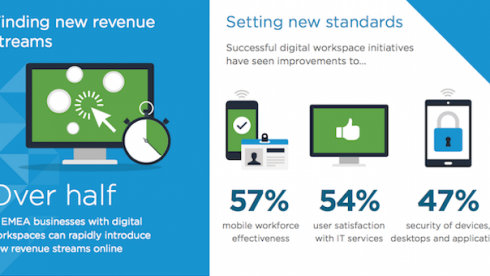DISCLAIMER: this article is older than one year and may not be up to date with recent events or newly available information.
Guestblog by Tom Vallons, Partner Development Specialist BUSINESS MOBILITY, VMware Benelux
Start-ups are renowned for their ability to respond swiftly to market changes and for running their operations much more efficiently than established enterprises. They live and breathe ‘digital’ and always put ‘mobile and cloud’ first. Is that a mission impossible for the rest of us? Not at all! But to be able to compete with the new kids on the block, traditional organizations first have to create a truly digital workspace.
Companies should start by asking themselves two questions:
1) Do we know which devices our employees use to connect to the enterprise network?
2) Do we allow them to connect using their own devices?
The answer to both questions will probably be: “No, we don’t.” While most companies know that mobile is here to stay, they are still struggling to find the right balance between flexibility, control and security.
At VMware, to help our customers unlock maximum value from their business mobility strategy, we guide them through the four crucial steps they need to take to create a digital workspace:
1. Eliminate desktop challenges
The benefits of ‘mobile and cloud first’ may seem at odds with the substantial investments companies have made in Windows desktop applications over the past decades. Since many desktop applications still play a crucial role in the day-to-day operations, organizations need to find a new and more efficient way of making them accessible on multiple devices. The goal is to decouple applications from specific hardware devices and to run them in the data center, making them available as a virtualized desktop or a published app.
2. Make mobile transparent
Giving employees access to enterprise applications and data on mobile devices doesn’t necessarily mean relinquishing control. Nor does it mean severely restricting the use of mobile devices from the employee perspective. One way to meet both sides’ needs is to ask employees to register the devices of their choice in a so-called ‘enterprise mobility management suite’. This way, organizations have a clear view of who wishes to connect using which types of devices. For each device type, the company can then devise a set of clear rules about access to e-mail and other applications.
3. Focus on the content
Enrolling employees’ mobile devices in an enterprise mobility solution is the first important step towards a company being able to map and manage the use of those devices. However, in terms of working more efficiently, the access to applications and data is more important than the devices themselves. The required information must be available anytime, anywhere, in a controlled and secure way. That’s why companies gain more benefit from choosing a data and application-centric approach than a device-centric one.
4. Put the user first
The ultimate aim of a digital workspace is to boost efficiency, which means going beyond merely providing employees with the tools that they need to do their jobs properly. Optimal success revolves around a strong user-centric approach in which employees have a single, central gateway with which they can connect using multiple devices. This gives them secure yet easy and direct access to all the data and applications they need, whenever and wherever they need them.
Furthermore, a user-centric approach enables companies to connect the dots between managing identity, devices and applications to then apply conditional access. The digital workspace supports each individual user differently, according to his or her role, responsibilities and location. For example, users in the office may have unlimited mobile access to all relevant applications but, for security reasons, these same users off site may have their access restricted to a smaller number of enterprise applications.
Future-proof your organization with a single interface
At VMware we strongly believe that creating a truly digital workspace is a huge enabler of business value. This is especially true now, as more and more ‘digital natives’ are embarking their professional careers and technological and mobile advancements – such as the Internet of Things – continue to gather pace. These trends will drive companies towards new and more efficient ways of working, preferably managed through a single interface within a single, integrated suite of enterprise mobility solutions.
Category: Mobility
Tags: Business Mobility, digital workspace, VMware Workspace





No comments yet